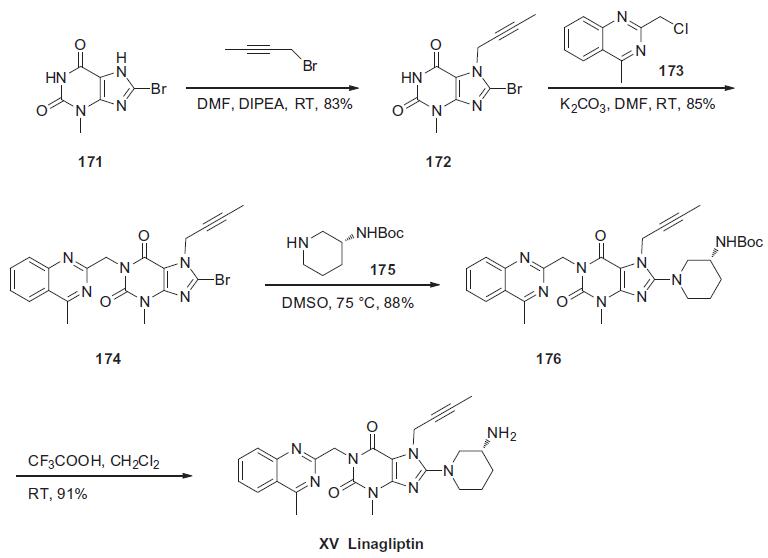|
| Product Name: | Linagliptin | | Synonyms: | linagliptin;8-[(3R)-3-Amino-1-piperidinyl]-7-(2-butynyl)-3,7-dihydro-3-methyl-1-[(4-methyl-2-quinazolinyl)methyl]-1H-purine-2,6-dione;(R)-8-(3-Amino-piperidin-1-yl)-7-but-2-ynyl-3-methyl-1-(4-methyl-quinazolin-2-ylmethyl)-3,7-dihydro-purine-2,6-dione;1H-Purine-2,6-dione, 8-((3R)-3-amino-1-piperidinyl)-7-(2-butynyl)-3,7-dihydro-3-methyl-1-((4-methyl-2-quinazolinyl)methyl)-;Bi 1356;Ondero;8-[(3R)-3-AMino-1-piperidinyl]-7-(2-butyn-1-yl)-3,7-dihydro-3-Methyl-1-[(4-Methyl-2-quinazolinyl)Methyl]-1H-purine-2,6-dione;8-[(3R)-3-AMino-1-piperidinyl]-7-(2-butynyl)-3,7-dihydro-3-Methyl-1-[(4-Methyl-2-quinazolinyl)Methyl]-1H-purine-2,6-d | | CAS: | 668270-12-0 | | MF: | C25H28N8O2 | | MW: | 472.54 | | EINECS: | 1308068-626-2 | | Product Categories: | TRADJENTA;Linagliptin;Amines;API;Pharmaceutical raw material;Inhibitor;Aromatics;Heterocycles;Intermediates & Fine Chemicals;Pharmaceuticals;668270-12-0 | | Mol File: | 668270-12-0.mol |  |
| | Linagliptin Chemical Properties |
| Melting point | 202 ºC | | Boiling point | 661.2±65.0 °C(Predicted) | | density | 1.39 | | storage temp. | Refrigerator | | solubility | Chloroform (Sparingly), DMSO (Slightly), Methanol (Slightly) | | pka | 10.01±0.20(Predicted) | | form | Solid | | color | White to Orange |
| | Linagliptin Usage And Synthesis |
| Uses | Linagliptin (TrajentaR, TradjentaTM, TrazentaTM, TrayentaTM) is an oral, highly selective inhibitor of dipeptidyl peptidase-4 and is the first agent of its class to be eliminated predominantly via a nonrenal route. Linagliptin is indicated for once daily use for the treatment of adults with type 2 diabetes mellitus.
| | Treatment of Type 2 diabetes | Linagliptin acts to lower blood glucose levels by inhibiting the enzyme DPP-4, thereby preventing the degradation of the incretin hormones (glucagon-like peptide-1 [GLP-1] and glucose-dependent insulinotropic peptide) and attenuating postprandial glucose excursions. By selectively targeting DPP-4, linagliptin potentially causes a more physiologically based control of glucose-dependent postprandial glucose excursions and of fasting blood glucose, both of which are mediated by effects of glucose on insulin and glucagon secretion. An advantage of linagliptin is that since incretin-stimulated release of insulin is glucose dependent, linagliptin is associated with a low incidence of hypoglycaemia. Moreover, DPP-4 inhibitors have a low potential for drug-drug interactions (with the exception of saxagliptin, which is metabolized by cytochrome P450 [CYP] 3A4/5), are generally well tolerated and have minimal or neutral effects on bodyweight.
| | Pharmacokinetics | Linagliptin shows modest oral bioavailability, and it is rapidly absorbed. The maximum plasma concentration at steady state is reached on average 1.5 hours after administration of linagliptin 5 mg, once daily . Linagliptin half-life is 131 hours. No relevant food effects were observed on the absorption profile of linagliptin. Unlike other DPP-4 inhibitors, linagliptin excretion is not performed by the kidneys, but rather through the enterohepatic system.
| | Description | Linagliptin (trade names Tradjenta and Trajetna) is an inhibitor of
dipeptidyl peptidase-4 (DPP-4) that was approved by the U.S. FDA in May
2011 for the treatment of Type 2 diabetes along with diet and exercise.
Linagliptin (BI-1356) has been
described as a potent highly selective, slow-off rate and long acting inhibitor of DPP-4. Linagliptin arose from optimization efforts of xanthine-based
DPP-4 inhibitors with the initial lead identified from an HTS campaign.
After optimizing the activity of the initial micromolar lead, two issues that needed to be addressed were activity for hERG and muscarinic receptor M1.
Introduction of a butynyl group at the N7 position of the xanthine ring gave
much reduced M1 affinity with no measureable hERG activity. Linagliptin
inhibits DPP-4 with an IC50=1 nM and is highly selective (>10,000-fold)
against DPP-8 and DPP-9. Linagliptin shows no interactions with CYPs up
to 50 mM. The described synthesis of linagliptin starts with 8-bromoxanthine,
which is alkylated at the N-7 position to introduce the butyne group,
followed by alkylation of the N-1 group to introduce the methyl-quinazoline
group. Displacement of the bromide with (R)-Boc-3-amino-piperidine
followed by deprotection gives linagliptin. When administered to db/db
mice orally, linagliptin dose dependently reduced glucose excursion from
0.1 mg/kg (15% inhibition) to 1 mg/kg (66% inhibition). | | Originator | Boehringer Ingelheim (United States) | | Uses | A novel potent and selective dipeptidyl peptidase-4 (DPP-4) inhibitor with potential use in the treatment of type 2 diabetes. | | Uses | dipeptidypeptidase inhibitor, antidiabetic | | Uses | highly potent CD26 inhibitor | | Uses | Labeled Linagliptin, intended for use as an internal standard for the quantification of Linagliptin by GC- or LC-mass spectrometry. | | Definition | ChEBI: A xanthine that is 7H-xanthine bearing (4-methylquinazolin-2-yl)methyl, methyl, but-2-yn-1-yl and 3-aminopiperidin-1-yl substituents at positions 1, 3, 7 and 8 respectively (the R-enantiomer). Used for treatment of type
I diabetes. | | Brand name | Tradjenta | | Clinical Use | Type 2 diabetes mellitus | | Synthesis | The synthesis of linagliptin began from commercially available
8-bromo-3-methylxanthine (171). Sequential alkylations
of guanine derivative 171 at N-7 with butyn-2-yl bromide
in the presence of N,N-diisopropylethylamine and N-1 with 2-
(chloromethyl)-4-methylquinazoline (173) in the presence of
potassium carbonate, yielded N1,N7-dialkylated xanthine 174 in
85% yield. This material was further condensed with (R)-3-Bocaminopiperidine
(175) in the presence of potassium carbonate to
give aminopurine dione 176 in 88% yield. Finally, the primary
amine of 176 was liberated with trifluoroacetic acid in methylene
chloride to produce linagliptin (XV) in 91% yield. 
| | target | DDP-4 | | storage | +4°C |
| | Linagliptin Preparation Products And Raw materials |
|